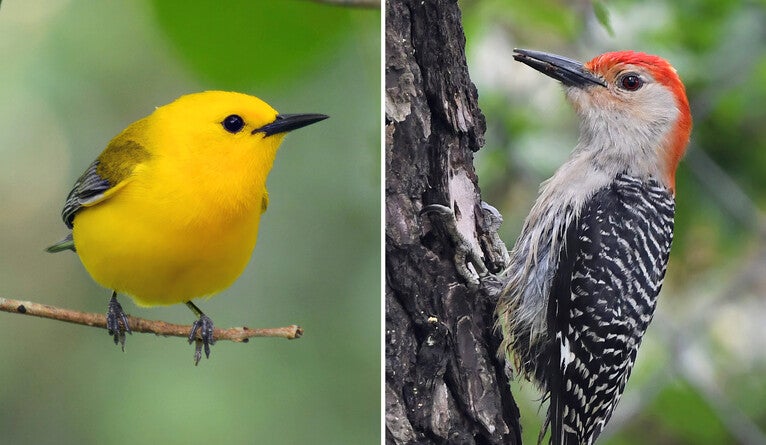From his office in New Haven, Yale ecologist Jeremy Cohen experiences the full range of the four seasons, from hot and humid summers to dry and chilly winters. But it occurred to him that many of his research subjects - North American birds - eschew the seasons, instead seeking the same weather conditions all year long across their migratory routes.
In a new study, done in collaboration with Walter Jetz, a professor of ecology and evolutionary biology at Yale, Cohen sought to better understand how different species of North American birds track these preferred climatic conditions (known to ecologists as the environmental niche) and which traits, such as diet, body size, or behavior, might predict these different strategies across species.
Writing in the journal Global Ecology and Biogeography, they uncovered diverse niche tracking strategies across the more than 600 species included in the study that are defined by tracking both averages and variability in the local environment and significantly associated with the ecological traits of those species, such as body size or diet.
"We found that some migratory species can track temperature or rainfall throughout the year, going out of their way to experience the same weather all year long, while others experience strong variation in seasonal conditions throughout the year," said Cohen, an associate research scientist in Jetz's lab.
Jetz, a member of Yale's Faculty of Arts and Sciences, is the director of the Yale Center for Biodiversity and Global Change.
For millions of individual bird occurrence records, Cohen determined the environmental conditions experienced at each record using satellite weather data, which allowed him to assess how those conditions experienced by each species change throughout the seasons. This analysis was the first to consider the importance of weather variability, not just averages, in determining how bird species track their niches across seasons. Past studies had evaluated only the average weather conditions, leaving crucial knowledge gaps about both the ecology and potential vulnerability of birds.
"For the first time, we can determine which species require strict consistency in both the average and variability of weather conditions throughout the year," Cohen said. "This is critical information when trying to determine vulnerability to climate change, which is shifting both the average and variability (or unpredictability) of weather conditions."

Long distance migrants, such as the prothonotary warbler, are terrific niche-trackers, Cohen found. Their migratory prowess means they can seek out preferred conditions all year long. Small-bodied birds, such as vireos, and insect-eaters, such as flycatchers, also tend to closely track their niches over the year, whereas large-bodied birds and herbivorous or omnivorous birds, including many woodpeckers, are able to withstand a wide range of conditions over the year.
"Knowing who has narrow requirements and who can withstand a broader range of conditions can help us predict climate change vulnerability," Cohen said.
A strict niche-tracker may find itself less able to cope with a changing climate than those more flexible species, and as Cohen uncovered, the distribution of these niche tracking strategies is not random. "Now we have a framework that can predict vulnerability to both changes in mean and variability based on the traits of different species of birds, even among species we were unable to cover in our study," he said.
Revealing these patterns was no simple task. For the study, Cohen and Jetz had to synthesize data from millions of occurrence records for over 600 bird species along with 22 years of weather data from the NASA MODIS instrument and CHELSA climate data set.
Such an undertaking would not have been possible even a decade ago, Cohen said. But today, he said, there is an enormous wealth of observational data about birds, mainly due to the contributions of "citizen scientists" worldwide. Cohen also relied on a tool developed recently by his colleagues in the Yale Center for Biodiversity and Global Change to "easily annotate millions of observations with fine-scale weather data across hundreds of species."
To Cohen, this study is just the beginning. While birds are perhaps the most well-known migrators in the animal kingdom, several ungulates - including deer and moose - and even butterflies can partially track their environmental niches while migrating throughout the year.
"The recent explosion in tracking data for many of these other species will soon allow us to ask these questions [about seasonal niche tracking and climate change vulnerability] in other taxa as well," said Cohen, who is optimistic that his framework will be widely applicable across these groups in the near future.
While much research on the relationship between species and climate change characterizes the world's species as "victims to the whims of the climate," Cohen said, the new findings suggest that niche tracking could be an important tool for some species to use seasonal movement to buffer against changing environmental conditions.
Even still, he said, the rate and extent of anthropogenic climate change is wholly unprecedented in recent decades, pushing many species into conditions that they have never experienced before.
"It's important to understand how wildlife may be handling the ongoing consequences of accelerating climate change so that, as climate change accelerates, we can prevent the collapse of ecological communities and biodiversity while avoiding the loss of ecosystem services," Cohen said.






